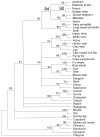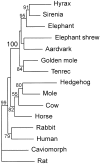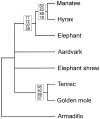Molecular evidence for multiple origins of Insectivora and for a new order of endemic African insectivore mammals
- PMID: 9707584
- PMCID: PMC21445
- DOI: 10.1073/pnas.95.17.9967
Molecular evidence for multiple origins of Insectivora and for a new order of endemic African insectivore mammals
Abstract
The traditional views regarding the mammalian order Insectivora are that the group descended from a single common ancestor and that it is comprised of the following families: Soricidae (shrews), Tenrecidae (tenrecs), Solenodontidae (solenodons), Talpidae (moles), Erinaceidae (hedgehogs and gymnures), and Chrysochloridae (golden moles). Here we present a molecular analysis that includes representatives of all six families of insectivores, as well as 37 other taxa representing marsupials, monotremes, and all but two orders of placental mammals. These data come from complete sequences of the mitochondrial 12S rRNA, tRNA-Valine, and 16S rRNA genes (2.6 kb). A wide range of different methods of phylogenetic analysis groups the tenrecs and golden moles (both endemic to Africa) in an all-African superordinal clade comprised of elephants, sirenians, hyracoids, aardvark, and elephant shrews, to the exclusion of the other four remaining families of insectivores. Statistical analyses reject the idea of a monophyletic Insectivora as well as traditional concepts of the insectivore suborder Soricomorpha. These findings are supported by sequence analyses of several nuclear genes presented here: vWF, A2AB, and alpha-beta hemoglobin. These results require that the order Insectivora be partitioned and that the two African families (golden moles and tenrecs) be placed in a new order. The African superordinal clade now includes six orders of placental mammals.
Figures



Similar articles
-
Molecular phylogenetic evidence confirming the Eulipotyphla concept and in support of hedgehogs as the sister group to shrews.Mol Phylogenet Evol. 2002 Oct;25(1):200-9. doi: 10.1016/s1055-7903(02)00232-4. Mol Phylogenet Evol. 2002. PMID: 12383761
-
Molecular evidence for the monophyly of tenrecidae (mammalia) and the timing of the colonization of Madagascar by Malagasy Tenrecs.Mol Phylogenet Evol. 2002 Mar;22(3):357-63. doi: 10.1006/mpev.2001.1055. Mol Phylogenet Evol. 2002. PMID: 11884160
-
Phylogeny and life histories of the 'Insectivora': controversies and consequences.Biol Rev Camb Philos Soc. 2005 Feb;80(1):93-128. doi: 10.1017/s1464793104006566. Biol Rev Camb Philos Soc. 2005. PMID: 15727040 Review.
-
Endemic African mammals shake the phylogenetic tree.Nature. 1997 Jul 3;388(6637):61-4. doi: 10.1038/40386. Nature. 1997. PMID: 9214502
-
Placentation in species of phylogenetic importance: the Afrotheria.Anim Reprod Sci. 2004 Jul;82-83:35-48. doi: 10.1016/j.anireprosci.2004.04.018. Anim Reprod Sci. 2004. PMID: 15271442 Review.
Cited by
-
Morphology and Mitochondrial Lineage Investigations Corroborate the Systematic Status and Pliocene Colonization of Suncus niger (Mammalia: Eulipotyphla) in the Western Ghats Biodiversity Hotspot of India.Genes (Basel). 2023 Jul 22;14(7):1493. doi: 10.3390/genes14071493. Genes (Basel). 2023. PMID: 37510398 Free PMC article.
-
The Reaction Specificity of Mammalian ALOX15 Orthologs is Changed During Late Primate Evolution and These Alterations Might Offer Evolutionary Advantages for Hominidae.Front Cell Dev Biol. 2022 Apr 21;10:871585. doi: 10.3389/fcell.2022.871585. eCollection 2022. Front Cell Dev Biol. 2022. PMID: 35531094 Free PMC article.
-
The effects of fossil taxa, hypothetical predicted ancestors, and a molecular scaffold on pseudoextinction analyses of extant placental orders.PLoS One. 2021 Sep 17;16(9):e0257338. doi: 10.1371/journal.pone.0257338. eCollection 2021. PLoS One. 2021. PMID: 34534236 Free PMC article.
-
Signatures of conserved and unique molecular features in Afrotheria.Sci Rep. 2021 Jan 13;11(1):1011. doi: 10.1038/s41598-020-79559-6. Sci Rep. 2021. PMID: 33441654 Free PMC article.
-
Exploring the ontogenetic development of the inner ear in Aardvarks.J Anat. 2021 May;238(5):1128-1142. doi: 10.1111/joa.13361. Epub 2020 Dec 21. J Anat. 2021. PMID: 33345316 Free PMC article.
References
-
- Huxley T H. Proc R Soc Lond. 1880;43:649–662.
-
- Matthew W D. Mem Am Mus Nat Hist. 1909;9:291–567.
-
- MacPhee R D E, Novacek M J. In: Mammal Phylogeny: Placentals. Szalay F S, Novacek M J, McKenna M C, editors. Vol. 2. New York: Springer; 1993. pp. 13–31.
-
- Butler P M. In: The Phylogeny and Classification of the Tetrapods: Mammals. Benton M J, editor. Vol. 2. Oxford: Clarendon; 1988. pp. 117–141.
-
- Broom R. Proc Zool Soc London. 1916;1916:449–459.
Publication types
MeSH terms
Substances
Associated data
- Actions
- Actions
- Actions
- Actions
- Actions
- Actions
- Actions
- Actions
- Actions
- Actions
- Actions
- Actions
- Actions
LinkOut - more resources
Full Text Sources
Miscellaneous


